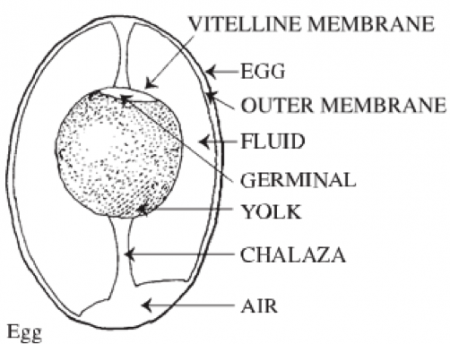Eggs
41 Composition and Nutrition
The three main components of eggs are the shell, the white, and the yolk. The average whole large egg, weighing 56 g (2 oz.) is composed of 12% shell, 58% white, and 30% yolk by weight. Protein is found in both the white and the yolk, but almost all of the fat is found in the yolk (see Figure 10 and Tables 13 and 14).

| Component | Whole Egg | Yolk | White |
|---|---|---|---|
| Moisture | 73.0 | 49.0 | 86.0 |
| Protein | 13.3 | 16.7 | 11.6 |
| Lipid | 11.5 | 31.6 | 0.2 |
Note that traces of sugar and ash are also present in an egg.
| Element | Whole Egg | Yolk | White |
|---|---|---|---|
| Weight | 50 g | 17 g | 33 g |
| Protein | 6 g | 3 g | 3 g |
| Fat | 5 g | 5 g | Trace |
| Cholesterol | 216 mg | 216 mg | 0 |
| Calcium | 25 mg | 2 mg | 27 mg |
| Iron | 1.0 mg | 0.6 mg | Trace |
| Sodium | 63 mg | 7 mg | 54 mg |
| Potassium | 60 mg | 16 mg | 47 mg |
| Vitamin A | 96 RE | 99 RE | 0 RE |
Note: B-complex vitamins, not itemized, are well represented in eggs, as are amino acids. “RE” stands for retinol equivalent, a term used in nutritional measurement.
Worth noting is the concentration of certain food elements in different parts of the egg. Note for example that all the cholesterol is in the yolk. The yolk is relatively rich in iron and the white is high in calcium.
In practice, when separating large eggs, one estimates the weight of the white as 30 g (1 oz) and the yolk as 20 g (0.7 oz). The colour of the shell, which is either a creamy white or brown, is relevant to the breed of the hen, and there is no other basic difference in the content of the egg or the shell.
The colour of the yolk depends on the diet of the hens. Bakers have a preference for eggs with dark yolks. Certainly the appearance of cakes made with such eggs is richer. Tests have found that, although eggs with darker yolks tend to produce moister sponge cakes, the cakes are somewhat coarser and less tender.
Image Descriptions
Figure 10 image description: Diagram demonstrates the components of an egg. First there is the outer shell (labelled “egg”), followed by the outer membrane, then fluid. The round yolk is at the centre of the egg. Beneath it is a strip called the chalaza, which leads to an air sac near the shell. At the top of the yolk is the germinal, and around the whole yolk is the vitelline membrane. [Return to Figure 10]

